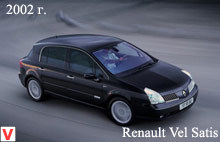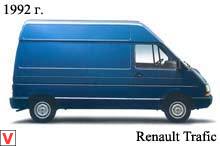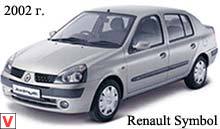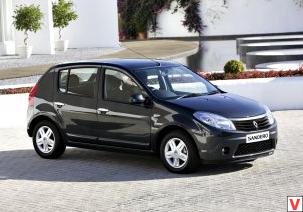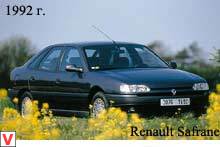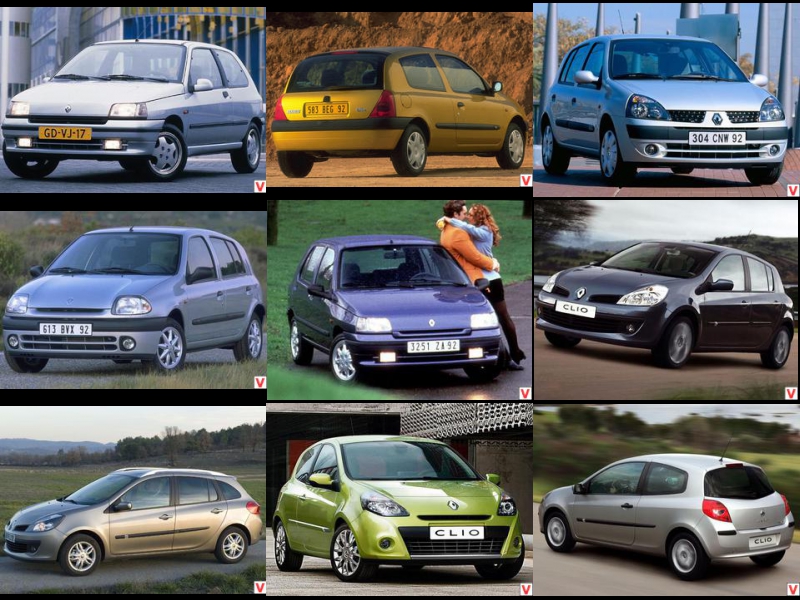
The subcompact car with the harmonious name Clio (the muse of history in Greek mythology) came to replace Renault 5 in the late 1990s. The first generation of this compact car with a transverse engine and front-wheel drive was a three- and five-door hatchback. A year later, Clio won the 1991 European Car Competition.
Thanks to a rational layout and revised technical solutions inside it offers more space for passengers and baggage. With an external length of 3.71 meters, the Clio has a spacious interior, a high level of safety, stability and controllability. An excellent addition to the attractive design was the high quality of the interior and layout. The internal dimensions of the cabin allow you to comfortably get four. Driving performance of the car can be described as a good combination of dynamism and softness. Suspension very smoothly filters the unevenness of the road surface, while the Clio perfectly keeps the trajectory in turn, is stable on a straight line.
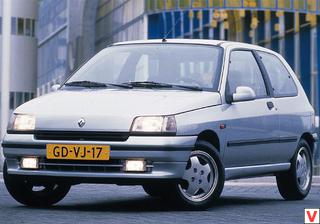
The cars of the first generation had ABS brakes, airbags and air conditioning. In 1993, the most powerful Clio came onto the market with the Williams prefix. This version was equipped with a two-liter 150-horsepower engine. In 1994, the first modernization was carried out: bumpers, headlights, some interior details were changed. In 1996, the Clio underwent a second restyling. The changes also mostly affected the front of the car, namely the bumpers and optics. The body of the first generation Renault Clio is galvanized, therefore it is reliably protected from corrosion. The spare wheel of the old tradition of the French automotive industry hangs under the bottom.
Installation of an economical 1.1-liter injection engine with 58 hp allowed to reduce the number of modifications, so at the time of the termination of the production of engines there were six, which was quite convenient not only for the company, but also for consumers. The main in the range remained gasoline inline four-cylinder 8-valve power units with a working volume of 1.2 liters (55 hp) and 1.7 liters (75 hp). A little later, they added a 1.8-liter 16-valve capacity of 109 hp.

In urban areas with him fuel consumption of only 10.3 l / 100 km. The most economical in the range was the 1.9-liter 64-horsepower diesel engine, which consumes 6.6 liters of fuel per hundred kilometers. Engines aggregated with a five-speed gearbox. Interior equipment is quite modest.
Elegant it is only in the top version of Clio Baccara, where you can see the skin, and wood, and full power accessories with air conditioning. Clio Williams is exclusive at all: there are not many of these cars, you can recognize them by the golden bumpers and alloy wheels, and in the salon each one has a sign with a serial number - also gold plated. For convenience, the Clio will give odds to most competitors: a large wheelbase, a low loading height of the trunk, the rear side window opens on three-door versions, and the “compartment” of the radio is covered by a plastic cover. The back of the seat folds in parts.
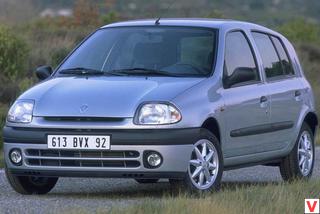
Because of this, the amount of luggage varies from 265 to 1060 liters in the three-door and five-door versions. The driver airbag was added at the end of 1995. The horn button is located not on the steering wheel, but at the end of the left-hand stalk switch. The first generation Clio was released in the amount of 3.8 million and won many fans of this model.
But in the autumn of 1998 at the Paris Motor Show showed Renault Clio II. Renault spent 3 years and 7.5 billion francs on the development of this model. The second generation has also become very popular. The model became slightly larger (6 cm longer and 3 cm taller) and gained a more rounded outline of the body. In Europe, cars are sold with a 3-and 5-door hatchback, but especially for the markets of the so-called third countries, in particular for Russia, the version of the Clio Symbol with a 4-door sedan with a length of 4.15 m is produced.
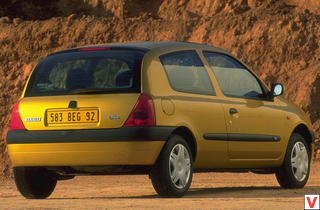
Clio II belongs to the upper subclass of an extra small class, that is, it is located between the Twingo minicar and the Megane small middle class model. The ideas of the new edge style and the classical European school are combined in the original appearance of the car. The new Clio looks very modern. Almost completely redesigned interior. A set of not very large but well-read dials is placed on the instrument panel under the original visor.
Salon Renault Clio is equipped with both the most necessary equipment and additional details that make the car more comfortable: a drawer under the front passenger seat, two cupholders in the center console and a spacious glove box with backlight. At least 50% of the components are new or have been seriously modified. An important innovation was the electric power steering. Unlike hydraulic, it requires much less energy costs, reducing fuel consumption and taking less power from the engine. The Renault Clio engine range has been enriched with a modern 16-valve 1.2-liter gasoline engine with 60 hp. and a 1.5-liter diesel engine with an 80 hp common rail system.
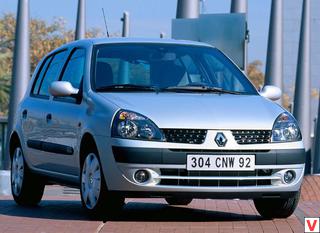
The 1.2-liter eight-valve, as well as 1.4, 1.6 and 1.9-liter engines with improved performance remained in production. Now, starting from the basic configuration level, the car is equipped with ABS, an emergency dorma system, adaptive front airbags, supplemented with side, belt pretensioners in the rear seats, and for the first time, a three-point Isofix child seat anchorage system. In the more expensive versions, an electronic stabilization system, a rain sensor, automatic headlight switching mode, and 15-inch alloy wheels are also provided. There is another option in the list of equipment - the navigation system.
Clio II has a completely new platform. The McPherson type front suspension is assembled on a vibration damping stretcher, and the track is increased by 40 mm. The rear suspension is not torsion, but semi-independent, with trailing arms that are attached to the body through rubber-metal bushings. Front disc brakes, rear drum.
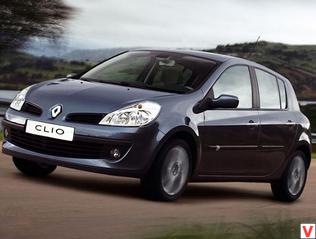
Since the summer of 1998, the model is equipped with a 1.6-liter engine and an automatic transmission. In the autumn of 1999, a Clio RS / Sport modification was produced jointly with Renault Sport. Its 2.0-liter engine develops 169 hp. and accelerates the car from zero to 100 km / h in just 7.3 seconds. The Clio family in 2000 underwent minimal changes. Standard equipment became 14-inch wheels, remotely controlled central locking, bumpers in body color. The 1.4-liter 16-valve inline “four” with a capacity of 98 hp, as well as a turbo-supercharged diesel engine of direct fuel injection with a displacement of 1.9 l and a capacity of 80 hp, added to the range of engines.
In the fall of 2000, sales of the most powerful of the Clio family, the Sport V6 model, began. This is a two-seater car created in collaboration with Renault Sport and Tom Walkinshaw Racing with a central location of a six-cylinder V-shaped engine with a displacement of 3.0 liters and a capacity of 230 hp. The new sports V6 has a stylish “nose”, aluminum body trim, as well as updated front and fog lights. New alloy wheels and thinner suspension components have made the car a little easier for the “progenitor”. In addition, the dashboard was updated and sport seats were installed. The third generation of the Clio was presented to the public in 2005.
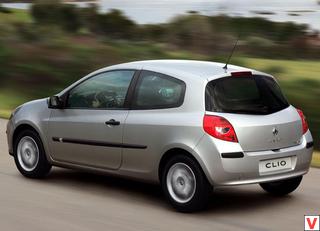
The sale of the 3-door version began in October 2005, and in early 2006 a 5-door version appeared. Clio III is built on platform B, developed jointly with Nissan. On the same platform built Renault Modus, Renault Logan (Dacia Logan), Nissan Micra and Nissan Note. At the same time, Clio II was not withdrawn from production, but continued to be produced under the name Clio Campus. In 2006, Renault introduced the Hi-Flex Clio II with a 16-valve 1.6 liter engine. Designed for Brazil, this car represents the concept of a Flex-Fuel engine capable of running on a mixture of gasoline and ethanol, and in any proportion from 0% to 100%.
Front bright design is emphasized by a large air intake at the bottom of the bumper. The lines of the grille and the central edge on the hood converge to a vertically located branded rhombus. The headlamp lines continue to shape the upper air intakes and bring dynamism to the appearance of the Clio III. The contours of the side surfaces of the body converge under the rear window in the shape of the letter V, which, together with the streamlined outline of the rear lights, gives the rear part of the car a finished look.

The third generation turned out much more and 130 kg heavier than the previous one. Thanks to the increased wheelbase, the cabin has become even more spacious. In the welcoming cabin can comfortably accommodate up to five people.
The concept of tactile design Touch Design is taken as a basis, thanks to which the interior looks soft and elegant, and because of the large glass area, the interior is literally flooded with light and looks even more spacious. Also, for the first time a keyless immobilizer is offered on Clio III. At the heart of the road qualities of the new model is the balance, which is achieved through a combination of long wheelbase, wide gauge and low center of gravity of the car. Clio III is serially equipped with an improved electric power steering, which makes driving a car soft and precise. The range of engines includes gasoline engines of 1.2 liters (75 liters. Pp.), 1.4 liters (100 liters.
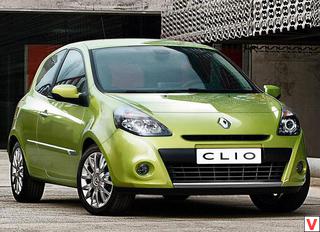
Pp.), 1.6 liters (110 liters. Pp.) And two 1.5-liter turbo diesel capacity of 86 and 106 liters .from. A speed controller and speed limiter allow the driver to maintain a constant vehicle speed or program a speed threshold. The first function - the “regulator” - is mainly used on highways and highways.
The second function "limiter" is used in populated areas and at high traffic density. It is noteworthy that the car received 5 stars in the safety rating EuroNCAP and 4 stars for the protection of children. In June 2006, sales of the Renault Clio Sport began in France. This version is equipped with a six-speed gearbox and a new aspirated 2.0-liter engine, created on the basis of a similar engine from the second generation.

Engine power is 145 kW (197 hp) at 7250 rpm. The maximum speed of 215 km / h, and acceleration of 0-100 km / h takes 6.9 seconds. In March 2007, the Clio was introduced in the station wagon. In 2009, the Clio was modernized. The updated design received a large air intake grille, other head optics and more stringent taillights. The three-door modification has especially won from this transformation - a purely family car appeared in a new sporting quality. The length of the updated three-door Clio - 4027 mm, width - 1707, height - 1493; wheelbase - 2575 mm, track - 1472/1470.
When fully seated in places, the capacity of the trunk is 288 liters, whereas when folding the rear seats it increases to 1040 liters. Accessories are offered that allow you to customize the appearance of the car: a sports body kit and lining, a spoiler and a larger exhaust pipe, chrome mirrors and special design wheels. The interior of the modernized Clio is no different from the previous version. There are only two configurations: the model with the “mechanics” comes in the performance of Confort, and with the “automatic” in the performance of Dynamique.
Both have electric mirrors and windows, adjustable seat height, side airbags and curtain airbags, antilock brakes, cruise control, cornering lights and fog lights. Options Dynamique supplemented CD-radio and separate climate control instead of air conditioning. Adaptation for the Russian market is reduced to increased ground clearance and bottom protection with steel sheets (the sports version of the Clio RS is delivered as it is). The tried and tested engine range starts from the 1.15-liter petrol 16-valve D4F with a maximum power of 75 hp.
at 5500 rpm. He, but with a turbocharger (D4FT) develops up to 101 forces, while the 1.6-liter K4M745, designed for a dynamic GT, gives out all 128 at 6750 rpm. GT version is gaining "a hundred" in 9.3 seconds. The maximum speed is 197 km / h. Average gas mileage 6.9 liters per 100 kilometers. If, for a potential buyer, fuel economy is particularly significant, then the K9K turbodiesel deserves its attention - from 68 to 106 hp. with 4 thousand revolutions. The engines are equipped with manual 5-speed gearbox, and only the most powerful "four" - gasoline and diesel - are paired with a 6-speed manual transmission.
And with a 1.6-liter engine from the K4M series with a maximum power of 112 forces, there is also a 4-speed hydromechanical “automatic”. Chassis Renault Clio did without fundamental changes: McPherson suspension in front, rear - on the conjugated trailing arms. Helical springs, transverse stabilizers; tires in size from 165/65 R15 (hatchback with a 1.15-liter “four” D4F) - up to 195 / 50R on 16-inch light-alloy wheels in the GT. Front brakes with ventilated discs with a diameter of 260 mm, while behind the ordinary drums. Circle disc brakes are equipped with a Clio version with a petrol 1.6-liter 16-valve and a 106-horsepower turbo diesel.
